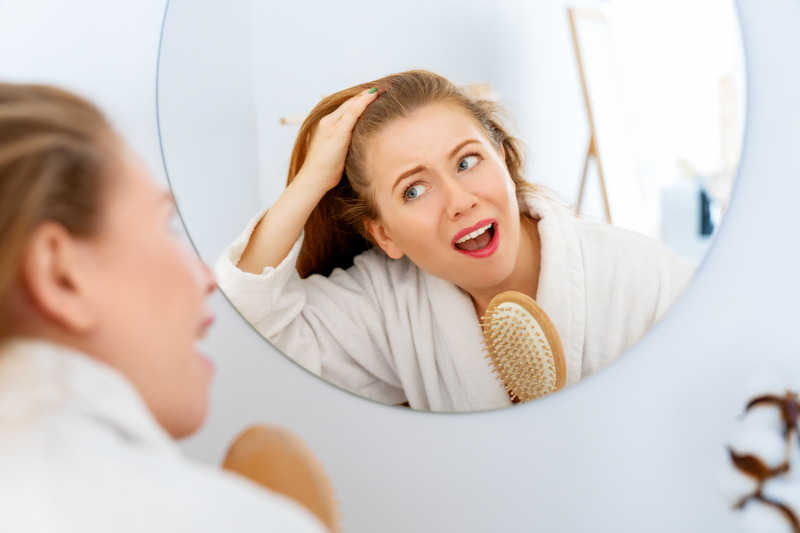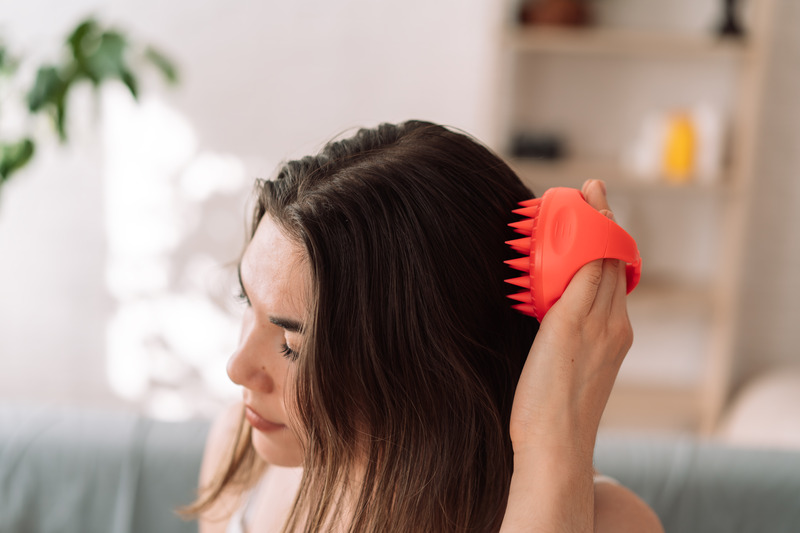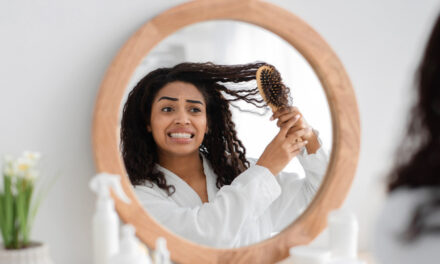
Maintaining a full and healthy head of hair is a priority for many, but damaged hair follicles can often impede healthy hair growth. This comprehensive guide is designed to aid in treating damaged hair follicles, addressing hair loss, fostering luscious locks, delving into the intricacies of hair health,
What are Hair Follicles?
Hair follicles are tiny sacs lined with skin cells, and they are responsible for hair growth. Each hair follicle plays a vital role, producing hair strands from the root beneath the skin surface.
Healthy hair follicles are essential to ensure that hair grows strong and resilient against breakage and thinning.
Common Causes Of Damaged Hair
Recognizing what causes hair damage is pivotal for maintaining healthy locks. A variety of factors, from lifestyle to environmental exposure, can negatively impact hair health.
Here, we will delve into these causes, providing insights for preserving the vitality of your tresses.
-
Genetics: Genetic factors, notably conditions like male pattern baldness, significantly affect hair follicles, leading to hair thinning and loss.
-
Tight Hairstyles: Wearing tight hairstyles can cause stress at the hair root, leading to damage in the hair follicle, which in turn can cause hair loss.
-
Environmental Exposure: Harsh weather conditions and environmental pollutants can affect hair follicles adversely, hindering healthy hair growth.
-
Hormonal Fluctuations: Changes in hormone levels, especially in women, can damage hair follicles, resulting in hair thinning and loss.
-
Nutritional Deficiency: A lack of essential nutrients can affect hair health, damaging hair follicles and impeding how hair grows.
Signs of Hair Follicle Damage

Understanding the signs of hair follicle damage is essential as it allows for timely intervention and treatment. The health of your hair follicles significantly influences the vitality and growth of your hair.
Here, we delve deeper into the signs that may indicate damage to the hair follicles:
Thinning Hair
One of the most discernible signs of hair follicle damage is hair thinning across various areas of the scalp. This isn’t limited to just one region but can be widespread, impacting the overall volume and density of the hair.
Thinning hair can be attributed to many factors, such as hormonal imbalances, nutritional deficiencies, or the disruption of the normal hair growth cycle, all of which affect hair follicles directly or indirectly.
Increased Hair Loss
Another prominent indicator is a marked increase in hair shedding and overall loss. Losing some strands is normal, but when the number escalates significantly and the loss is persistent, it could signal damaged hair follicles.
Increased hair loss can manifest stress, underlying health conditions, or harsh hair care products that compromise the integrity of the hair follicles.
Bald Patches
The emergence of bald or thinning patches on the scalp is a clear sign of hair follicle distress. This localized hair loss can result from alopecia areata, where the immune system mistakenly targets hair follicles, leading to hair fall in distinct, often circular patches.
Addressing this sign is crucial as it can provide insights into the underlying causes and facilitate timely treatment.
Brittleness
When hair becomes more brittle, losing its natural shine and strength, it often reflects compromised hair follicle health. Brittle hair is prone to breakage and split ends, so investigating the contributing factors is essential.
This could range from a lack of moisture and essential oils to exposure to excessive heat and chemical treatments, which can adversely affect hair follicles.
Reduced Hair Growth
Observing a noticeable decrease in the rate of hair growth is a telltale sign of potential hair follicle damage. Hair grows in cycles; any disruption in these cycles can lead to slower growth rates and shorter, weaker hair strands.
Reduced hair growth can stem from hormonal imbalances, aging, or other factors that impede the normal functioning of hair follicles.
How to Repair Damaged Hair Follicles

Repairing damaged hair follicles is a meticulous journey, encompassing a variety of holistic strategies and targeted interventions. Ensuring hair follicles are healthy is the cornerstone for fostering strong, vibrant hair growth and mitigating hair thinning and loss.
Below, we delve into an in-depth definition of the multifaceted approach on how to treat damaged hair follicles:
1. Understand the Causes
Acknowledging and addressing the root causes of damaged hair follicles is the first step toward effective treatment and prevention. Whether it’s habitual use of tight hairstyles, exposure to harsh chemicals, or environmental stressors, understanding the source of the damage allows for the formulation of personalized preventative and curative measures.
This foundational knowledge enables individuals to make informed decisions to foster hair health and counteract factors compromising hair follicle integrity.
2. Scalp Massage
Scalp massages can increase blood circulation to the hair follicles, promoting hair growth and helping treat thinning hair. Massages enhance blood circulation to the scalp and promote healthy hair growth by promoting essential nutrients to the hair roots.
Regular scalp massages can alleviate tension, stimulate hair follicles, and contribute to the overall wellness of the scalp, making it a valuable practice for those seeking to repair and rejuvenate damaged hair follicles.
3. Hair Growth Supplements
Incorporating hair growth supplements into your routine can provide the essential nutrients required for maintaining hair health and repairing damaged hair follicles. These supplements contain vitamins, minerals, and antioxidants necessary for hair vitality.
By addressing nutritional gaps and fortifying the body with necessary nutrients, hair growth supplements can enhance the resilience of hair strands, facilitate the repair of damaged hair follicles, and foster an environment conducive to robust hair growth.
4. Gentle Hair Care
Opting for a gentler hair care routine, including mild shampoos and conditioners, can prevent further damage to the hair follicles. Utilizing mild, nourishing shampoos and conditioners, minimizing heat styling, and avoiding harsh chemical treatments can preserve the hair’s natural integrity.
This approach underscores the importance of tenderness and care in maintaining healthy hair follicles and ensuring the longevity of hair health.
5. Avoid Tight Hairstyles
Steering clear of tight hairstyles can alleviate stress on the hair root, allowing the damaged hair follicle to recover. Consistent tension can strain and damage hair follicles, impeding their ability to support healthy hair growth.
By choosing looser, more relaxed hairstyles, individuals can mitigate the risk of follicular damage and create a supportive environment for hair follicles to recover and thrive.
6. Environmental Protection
Environmental factors such as UV rays, pollution, and extreme weather conditions can adversely affect hair follicles. Implementing protective measures, such as wearing hats and utilizing UV-protectant hair products, can shield hair from environmental aggressors.
This protective approach is instrumental in maintaining the health of hair follicles and preventing extrinsic damage.
7. Regular Exfoliation
Exfoliating the scalp helps remove dead skin cells, unclog hair follicles, and create a conducive environment for healthy hair growth, contributing to the overall health of the scalp. This practice facilitates optimal nutrient absorption, enhances circulation, and creates a conducive environment for healthy hair growth, making it an essential component of repairing damaged hair follicles.
8. Balanced Nutrition
Maintaining a balanced diet rich in essential vitamins, minerals, and antioxidants is paramount for optimizing hair health. Nutrients like Vitamin E, Omega-3 fatty acids, and proteins play a crucial role in keeping the hair follicles healthy and promoting hair growth.
Ensuring a consistent intake of these nutrients can combat hair thinning, reinforce hair strength, and contribute significantly to the revitalization of damaged hair follicles.
9. Regular Exercise
Physical activity is beneficial for overall health and a key contributor to healthy hair growth. Regular exercise enhances blood circulation throughout the body, including the scalp, ensuring that hair follicles receive adequate nourishment.
This increased blood flow can stimulate dormant hair follicles, encouraging growth and aiding in the repair process of damaged ones.
10. Stress Management
Chronic stress is a well-known catalyst for hair loss, negatively affecting hair follicles and their overall health. Managing stress through relaxation techniques, mindfulness, and adequate sleep can help mitigate the negative impacts on hair health.
Including stress-reducing activities like yoga, meditation, or deep breathing exercises can promote a calm mind and healthy hair growth.
11. Adequate Hydration
Water is essential for overall health, including the vitality of hair. Staying adequately hydrated helps in maintaining the moisture balance of the hair and scalp, preventing dryness and brittleness.
Adequate hydration supports the optimal functioning of cells, including those of hair follicles, and is integral to maintaining the hair’s natural luster and strength.
12. Avoiding Harsh Chemicals
Being mindful of the products used on hair is vital. Opting for hair care products free from harsh chemicals, sulfates, and parabens can prevent further damage to the hair follicles.
Choosing organic, natural products can nourish the hair, enhance its texture, and contribute to the overall health of the hair and scalp.
Conclusion
Keeping your hair follicles healthy is paramount for maintaining healthy hair growth and preventing hair loss. Understanding the pivotal role each hair follicle plays, identifying signs of damage, and implementing effective treatments are key steps in this journey.
From regular scalp massages and nutritional supplements to gentle hair care and protection against environmental damage, several strategies can help repair damaged hair follicles and promote hair health.
Looking for hair care products? Check out Vitamins Revive, a one-stop shop for all your hair care needs! At Vitamins Revive, we carry top-quality shampoos, conditioners, and treatments designed to provide the nutrients your hair needs. Shop now and start your journey to strong, healthy hair!
FAQ’s
Can damaged hair follicles be fully repaired?
Yes, depending on the cause and extent of the damage, many hair follicles can be repaired with appropriate care and treatment.
How long does it take for damaged hair follicles to recover?
The recovery time for damaged hair follicles can vary depending on individual factors and the severity of the damage. Still, improvements can typically be seen in a few months with consistent care and treatment.
Are hair growth supplements effective for all types of hair follicle damage?
Hair growth supplements can aid in providing essential nutrients for hair health, but their effectiveness may vary depending on the cause of the follicle damage. It’s always best to consult a healthcare professional before starting any new supplement regimen.
Can tight hairstyles permanently damage hair follicles?
Tight hairstyles can lead to traction alopecia, which causes hair loss due to pulling on the hair root. If the tension is prolonged, it can cause permanent damage to the hair follicles.
How does a healthy diet contribute to repairing damaged hair follicles?
A balanced and nutritious diet provides the essential vitamins and minerals needed for optimal hair health, supporting the repair and regeneration of damaged hair follicles.









